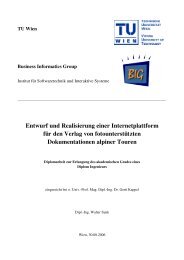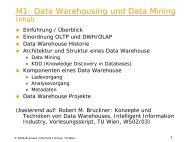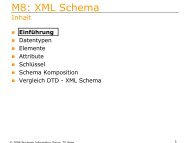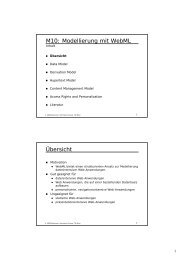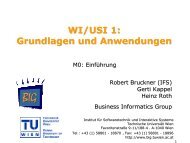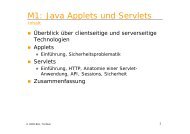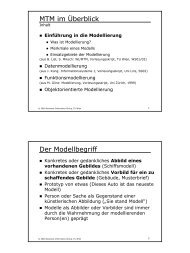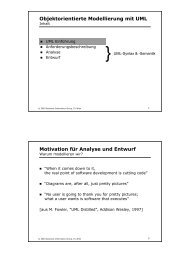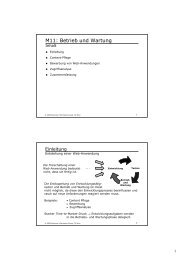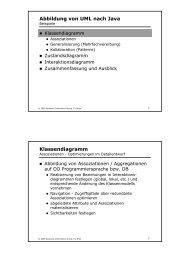Ph.D. Thesis - Business Informatics Group
Ph.D. Thesis - Business Informatics Group
Ph.D. Thesis - Business Informatics Group
You also want an ePaper? Increase the reach of your titles
YUMPU automatically turns print PDFs into web optimized ePapers that Google loves.
Chapter 1 Introduction<br />
tion code as the only integration description, it is hard to get an idea what really happens in<br />
the transformation, e.g., which information is lost in the transformation. Information loss is<br />
actually a problem when models are exported from tool A into tool B and then back from<br />
tool B into tool A, which is a quite common tool integration scenario.<br />
Requirements for the Metamodel Bridging Framework. First, for tackling the mentioned<br />
problems, a framework should be developed for building reusable mapping operators<br />
which are used to define so-called metamodel bridges. Such metamodel bridges allow<br />
the automatic transformation of models. For this, a uniform formalism should be used<br />
not only for representing the transformation logic together with the metamodels and the<br />
models themselves, but also for executing the transformations.<br />
Second, the proposed framework should be applied for defining a set of mapping operators<br />
subsumed in a mapping language which is intended to resolve typical structural<br />
heterogeneities occurring between the core concepts usually used to define metamodels as<br />
provided by the OMG standard MOF [OMG04]. In case a problem is not directly solvable,<br />
new mapping operators can be defined by the user or the operational semantics of existing<br />
mapping operators can be tweaked.<br />
Third, the defined metamodel bridges in terms of mapping operators, should allow the<br />
engineering of roundtrip transformations. This kind of transformations is especially needed<br />
for tool integration, namely if models are transformed from tool A to tool B and then back<br />
again to tool A. In such scenarios it is important that no information is lost during the transformation.<br />
However, practice shows that information loss often occurs in modeling tool<br />
integration, because of the high possibility of missing correspondences in mapping models.<br />
Therefore, mechanisms are needed that can support the user by developing roundtrip<br />
transformation in a systematic way where mapping models play a crucial role.<br />
1.2 Contribution of This <strong>Thesis</strong><br />
In regard of these crucial problems and requirements for Tool Adapters and the Metamodel<br />
Bridging Framework, the contribution of this thesis is threefold.<br />
Contribution 1. To ease the burden of developing tool adapters for each tool combination<br />
again and again, we propose a mining pattern for metamodels and models which can<br />
be used for implementing bridges on the M3-layer between two different meta-languages.<br />
With the term mining, we are not referring to stochastic methods such as used in the area<br />
of data mining [HK00], instead, we use the term mining as a name for the process of generating<br />
model-based representations out of text-based descriptions. In particular, we have<br />
implemented this mining pattern in the DTD2Ecore framework, a framework for producing<br />
Ecore-based metamodels out of Document Type Definitions (DTD). Therefore, we present a<br />
semi-automatic process how a language definition described in a language with limited expressiveness,<br />
e.g., DTD, is transformed into a language definition described in a language<br />
10



